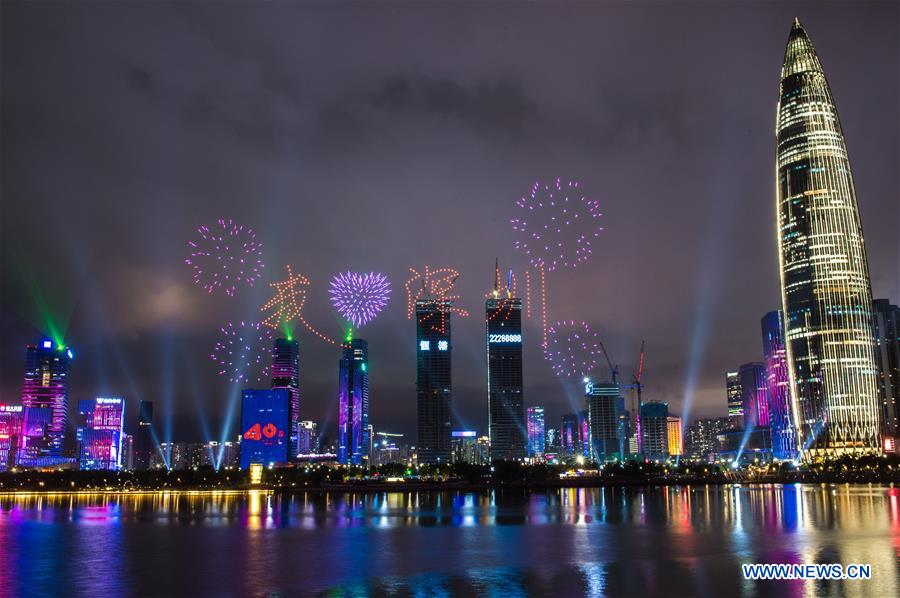40 years on, Shenzhen still China's reform and opening-up paragon
 0 Comment(s)
0 Comment(s) Print
Print E-mail Xinhua, August 27, 2020
E-mail Xinhua, August 27, 2020

Southern Chinese city of Shenzhen, a landmark in the country's reform and opening-up drive, on Wednesday marked the 40th anniversary of the establishment of the special economic zone.
Over the past four decades, Shenzhen has transformed from a small fishing village into a modern metropolis with a permanent population of over 13 million. It is still in the vanguard of China's development as a reform and opening-up paragon.
The Shenzhen speed
On Aug. 26, 1980, the 15th meeting of the Standing Committee of the fifth National People's Congress, the national legislature, approved the establishment of special economic zones in Shenzhen, Zhuhai and Shantou in Guangdong Province and Xiamen in Fujian Province.
Ever since then, Shenzhen has created a miracle in development. This can be seen in the figures.
From 1979 to 2019, Shenzhen's gross domestic output (GDP) rose at an annual growth rate of 21.6 percent to 2.69 trillion yuan (about 388.89 billion U.S. dollars), its per capita GDP also skyrocketed from 606 yuan to 203,489 yuan.
Shenzhen has now become the "Silicon Valley of China" and is regarded an "engine" for the Guangdong-Hong Kong-Macao Greater Bay Area's development into a vibrant world-class city cluster.
On average, there are 8.5 state-level high-tech enterprises per square km in Shenzhen, and an average of 71 invention patents are authorized every day.
As Shenzhen kick-started a brand-new market-oriented development pattern in 1980, a raft of reforms have been carried out in the city, which created countless firsts on the Chinese mainland, including the first land auctioned, the first stock issued and the first export industrial zone set up after the founding of the People's Republic of China in 1949.
"From the very beginning, Shenzhen's reform and opening-up has been endowed with the feature of boldly looking for breakthroughs from existing experiences, which is also the starting point of China's great success," said Tao Yitao, director of the China Center for Special Economic Zone Research at Shenzhen University.
In 1984, China opened 14 coastal cities. Four years later, the tropical island of Hainan became a province and a special economic zone. In 1990, China started to develop and open up Shanghai's Pudong, which has now become an investment haven for foreign firms.
Shenzhen dream, Chinese dream
"There would be no Shenzhen without the policy of reform and opening up," said Wang Chuanfu, chairman of China's leading new-energy vehicle (NEV) manufacturer BYD. "And likewise, there would be no BYD without Shenzhen."
Wang has been chasing his dream, like millions of others, in Shenzhen since 1995. Over the past 25 years, BYD has grown from a battery manufacturer into a leading NEV producer. It has obtained more than 18,000 patents, with products reaching customers in more than 50 countries and regions.
"We have taken root in Shenzhen and worked hard to master the core technology. The competitiveness of BYD is getting stronger and stronger, and our road is getting wider and wider," said Wang in pride.
Shenzhen now boasts eight Chinese Fortune 500 firms such as Huawei, Tencent, Vanke and Ping An Insurance, ranking third on the Chinese mainland in terms of the number of such enterprises, and nearly 300 overseas Fortune 500 enterprises have settled in the city.
"For 40 years, Shenzhen has explored a unique development path to driving China's modernization and achieving the goal of common prosperity," said Tao.
New mission
In August last year, Shenzhen, the trailblazer in China's reform and opening up, received a new mission. A guideline issued by the Communist Party of China Central Committee and the State Council said Shenzhen will be built into a pilot demonstration area of socialism with Chinese characteristics.
Pilot demonstration means that Shenzhen should not only be a pioneer but also serve as a model for other cities, so as to build an "ideal city" of socialism with Chinese characteristics, said Wu Sikang, a researcher with the Development Research Center of the Shenzhen government.
The guideline laid out a timeline for the city's development -- by 2025, it will become a leading city globally in terms of economic strength and quality of development; by 2035, not only will it become a national model of high-quality development, but also a hub of innovation, entrepreneurship and creativity with international influence.
"Shenzhen's role as the trailblazer in marketization, internationalization and legalization has put it on the fast track of development in the 40-plus years of reform and opening-up," said Song Ding with the China Development Institute (CDI) based in Shenzhen. "It's also the reason the central government made it a pilot demonstration area."
Experts also believe that Shenzhen's development model will inject incentives into the regional integration of the Guangdong-Hong Kong-Macao Greater Bay Area.
After implementing a number of reforms to improve the business system, Shenzhen continues to optimize the business environment this year in such areas as business registration, administrative approval and tax payment.
"Shenzhen should create even better policy, financial, law and integrity environment for enterprises and continue to play a leading role in China's reform and opening-up," said Li Luoli, vice chairman of the CDI.






Go to Forum >>0 Comment(s)